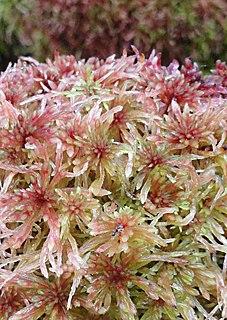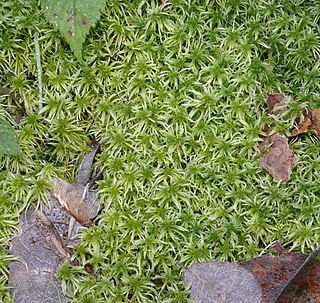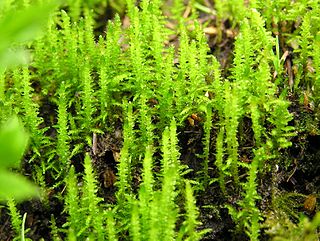Related Research Articles
Bryum warneum, known as sea bryum or Warne's threadmoss, is a protected moss found in sandy coastal areas in temperate regions of Europe and is also recorded to have been found in the Himalaya, the Altai Mountains and in Quebec, Canada.
Thamnobryum angustifolium, the Derbyshire feathermoss, is a species of moss in the Neckeraceae family. It is endemic to Derbyshire, England, being restricted to a single SSSI, where the main colony covers about 3 square metres (32 sq ft) of a single rock face, with small subsidiary colonies nearby. Threats include disturbance from cavers and climbers, collection by bryologists, pollution of the spring in which it grows, and desiccation during periods of drought. Its natural habitat is rivers.
Oedipodium is the only genus of moss in the family Oedipodiaceae. It contains the single species Oedipodium griffithianum, the gouty-moss or Griffith's oedipodium moss. This species is distributed in cooler climates of Eurasia, as well as from Alaska, Washington state, British Columbia, Yukon, Greenland, Newfoundland, Tierra del Fuego and the Falkland Islands.

Discelium is the only genus of moss in the family Disceliaceae; it contains the single species Discelium nudum, the flag-moss. This species is rare, but is widely distributed in cool and temperate climates of the Northern Hemisphere.
Didymodon tomaculosus, the sausage beardmoss, is a rare moss in the United Kingdom which has been noted as an important species in Natural England's Farm Environmental Plan book, part of the Environmental Stewardship Scheme.
Bryum dixonii, commonly known as Dixon's threadmoss, is a moss endemic to Scotland. The species occupies montane habitats, and although rare it has a wide distribution including the central and north-west Highlands, and the islands of Skye, Rùm and St Kilda. Originally discovered on Ben Narnain, Argyll, in 1898 by Hugh N. Dixon, it was not seen again until 1964 when found by Ursula Duncan at Juanjorge in Glen Clova in Angus. As of 2000 there was no species action plan for its protection.

Sphagnum angustifolium, the fine bogmoss, is a species of peat moss with a Holarctic distribution.

Sphagnum russowii, Russow's sphagnum or Russow's bogmoss, is a species of peat moss with a Holarctic distribution.

Sphagnum girgensohnii, the Girgensohn's bogmoss, Girgensohn's sphagnum or common green peat moss, is a species of peat moss with a Holarctic and Indo-Malesian distribution.

Dicranoweisia crispula, the mountain pincushion, is a species of mosses that lives at both poles. It grows in the South Shetland Islands and on the Antarctic Peninsula.
Zygodon gracilis, the slender yokemoss, is a moss species in the genus Zygodon.

Splachnum sphaericum, also known as pinkstink dung moss, is a species of moss. This species occurs in North America. It also occurs in upland Britain, where it is known as round-fruited collar-moss and in north temperate and boreal regions of Europe. Its habitat is bog and wet heathland where it grows on herbivore dung. This and other Splachnum species are entomophilous. The sporophytes, which are generally coloured red or black, produce an odour of carrion that is attractive to flies and the spores are dispersed by flies to fresh dung.

Calliergon cordifolium is a species of moss in the Calliergonaceae family, commonly known as the calliergon moss or heart-leaved spearmoss. The species is abundant in the right habitat, and grows in marshes and wet woodland, especially woodland of alder (Alnus) or willow (Salix), as well as around streams, ditches and pools. The species grows in tufts among other moss species. Calliergon cordifolium requires a wet environment to grow, and often grows completely submerged in water. It typically prefers lowland, but has been recorded as high as 910 metres (1,000 yd) above sea level in Inverness, Scotland. The species has a circumpolar Boreo-temperate distribution. It is found throughout Europe. It has been recorded in north and central Asia, as well as Turkey and Japan, throughout North America and in New Zealand.

Hennediella heimii, also known as Heim's pottia, is a moss with 2.5 mm brown or yellow-green tufts.

Sphagnum fallax, the flat-topped bogmoss, is a moss species in the genus Sphagnum

Palustriella commutata, commonly known as curled hookmoss, is a plant that also goes by the binomial names Cratoneuron commutatum, Cratoneuron falcatum, Hypnum commutatum, and Hypnum falcatum.

Mnium stellare, the starry thyme-moss or stellar calcareous moss, is a moss species in the genus Mnium.

Sphagnum fimbriatum, the fringed bogmoss, is a slender Sphagnum moss.

Rhizomnium punctatum, also called dotted thyme-moss, is a small species in the genus Rhizomnium.

Hookeria lucens, the shining hookeria, is a species of moss in the family Hookeriaceae. It is native to Europe, east to the Caucasus, Turkey and China, as well as Scandinavia and the Faeroe Islands and western North America.